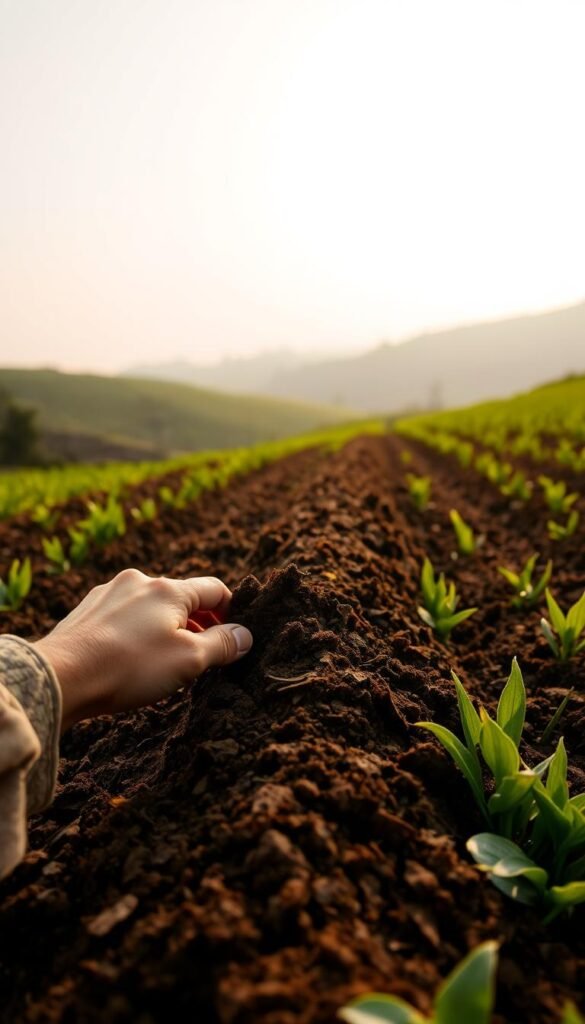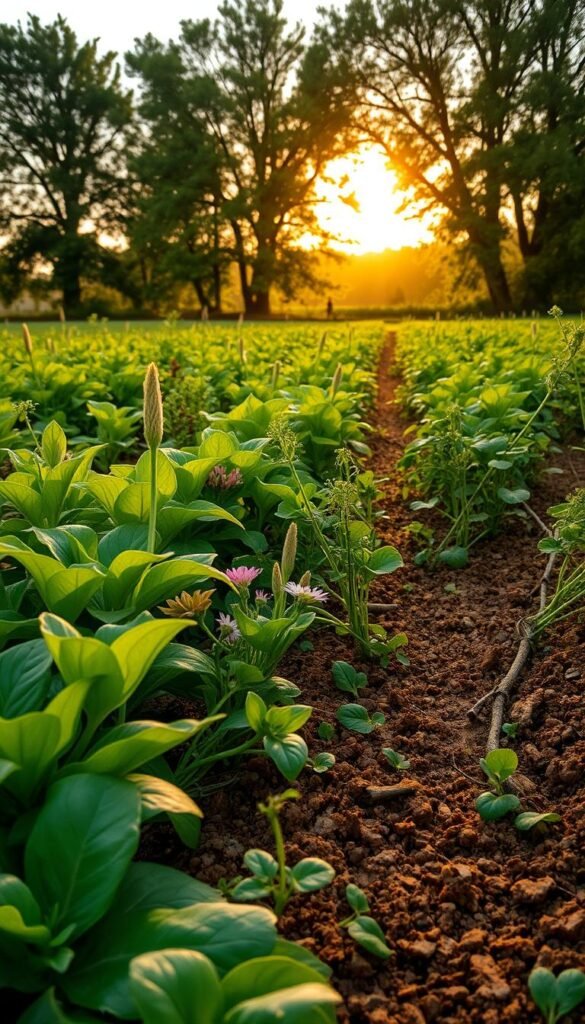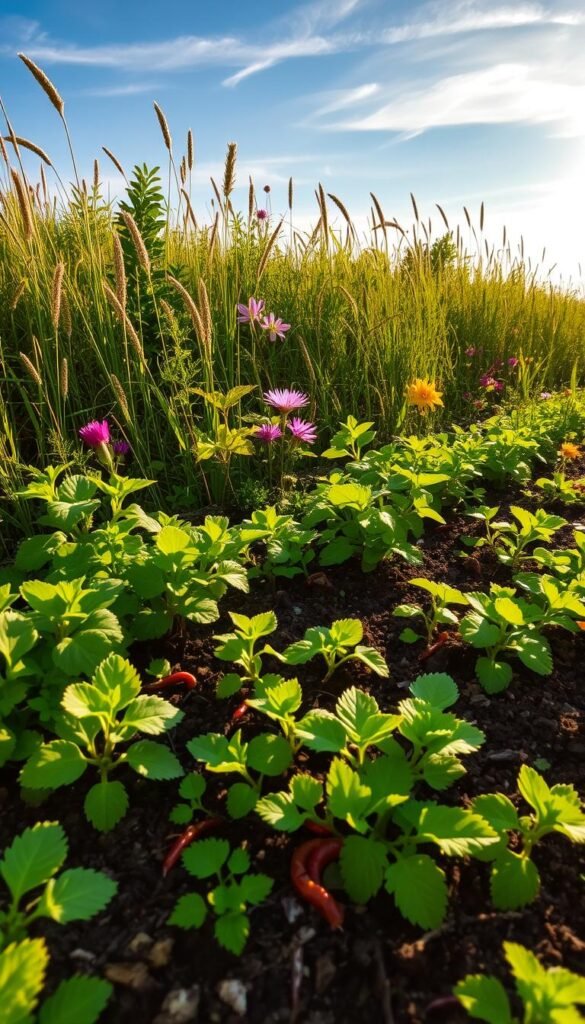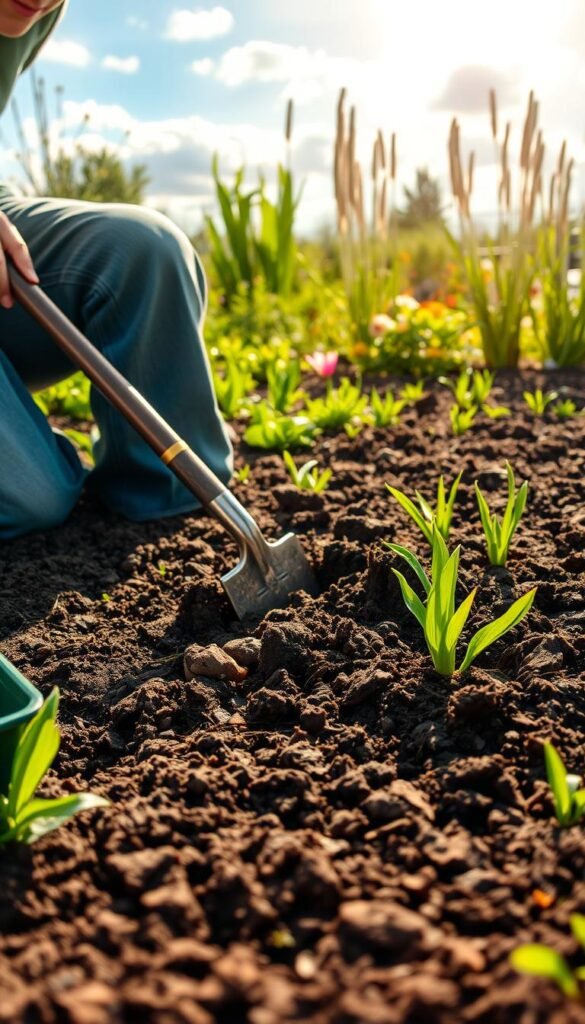Your garden’s success starts with what’s beneath your feet. Vibrant ecosystems in the ground fuel plant growth, recycle nutrients, and create natural resilience against weather extremes. When you nurture this living foundation, your plants thrive with less effort—no matter what the forecast brings.
Think of your garden as a team effort between earth, roots, and beneficial organisms. Microbes break down organic matter, worms aerate the dirt, and plant roots create pathways for water. This teamwork builds fertility that lasts through droughts, heavy rains, and temperature swings.
Seasonal shifts test this delicate balance. Cold winters slow microbial activity, while summer heat can bake moisture from the earth. By adapting your care routine to these changes, you’ll help your garden bounce back faster. Healthier dirt means stronger plants that naturally resist pests and diseases.
In this guide, you’ll find science-backed methods to boost your garden’s natural defenses. Learn how to work with nature’s rhythms instead of against them. Discover why experts call fertile earth the “secret weapon” for reducing synthetic fertilizers and watering needs.
Ready to grow plants that flourish in every season? Let’s dig into the strategies that turn good dirt into great results—year after year.
Understanding Seasonal Shifts in Your Soil

Weather patterns are rewriting the rules of gardening. Warmer winters and unpredictable rainfall create new challenges for your dirt’s ecosystem. Let’s explore how these changes affect the underground world that feeds your plants.
When Rain Becomes a Double-Edged Sword
Heavy downpours wash away nutrients faster than ever. A single storm can strip topsoil and leave roots gasping for air. This runoff carries away nitrogen and phosphorus – key ingredients your veggies crave.
Heat’s Hidden Toll on Underground Allies
Microbes work overtime in warm conditions, breaking down organic matter too quickly. While this sounds helpful, it actually starves your dirt of long-term nourishment. Tilled earth loses these benefits three times faster than undisturbed ground.
| Weather Event | Soil Impact | Plant Warning Signs |
|---|---|---|
| Extended Rain | Compacted layers | Yellowing leaves |
| Sudden Drought | Cracked surface | Wilting stems |
| Temperature Swings | Microbe imbalance | Stunted growth |
Smart gardeners adapt by watching moisture levels like hawks. Squeeze a handful of earth – if it crumbles immediately, your dirt’s crying for seasonal care strategies. Proper timing makes all the difference between survival and thriving.
How to Maintain Soil Health Through Seasonal Changes: Essential Strategies

Nature’s best soil helpers work while you rest. Strategic planting between growing seasons creates underground highways for water and nutrients. These living tools shield your garden from erosion while feeding microscopic allies beneath the surface.
Green Guardians for Every Season
Winter rye and crimson clover transform fallow ground into nutrient factories. Their roots break up compacted earth, letting rain soak deep instead of pooling. As they grow, these plants capture nitrogen and other elements your spring veggies will devour.
Summer buckwheat thrives in heat, smothering weeds while attracting pollinators. When chopped down, its stems become instant mulch. This cycle builds organic matter naturally – no bags of fertilizer required.
| Cover Crop | Key Benefit | Best Season |
|---|---|---|
| Clover | Nitrogen fixation | Fall/Spring |
| Rye | Erosion control | Winter |
| Vetch | Weed suppression | Early Spring |
| Buckwheat | Quick organic matter | Summer |
Timing matters most. Sow winter varieties 4-6 weeks before frost using seasonal soil amendment strategies. For heavy clay, try daikon radish – its taproots drill through hardpan like nature’s plow.
Pair these green protectors with no-till practices for maximum impact. As crops decompose, they feed earthworms and fungi that boost soil structure. This approach mirrors natural cycles, as detailed in our guide to prepping your soil for spring.
Embracing Organic Matter and Water Management

Feed your soil like a living ecosystem, and watch resilience grow. Tiny particles team up with decomposed plant material to create nature’s perfect growing medium. This partnership determines whether rain becomes a blessing or a curse for your plants.
Utilizing Compost, Manure, and Natural Fertilizers
Think of compost as multivitamins for your dirt. A yearly inch-thick layer boosts organic matter by 3-5%, creating crumbly texture plants adore. Pelletized manures from alpacas or rabbits simplify application – their slow-release nutrients won’t burn delicate roots.
Enhancing Water Infiltration and Reducing Erosion
Healthy dirt drinks rain like a sponge. Water infiltration rates double when organic content reaches 5%, cutting runoff that causes soil erosion. Try this test: pour a cup of water on amended ground. If it disappears in 10 seconds, you’ve nailed it.
| Amendment | Water Absorption Boost | Erosion Protection |
|---|---|---|
| Compost | 40% faster | High |
| Rabbit Manure | 25% faster | Medium |
| Leaf Mold | 35% faster | High |
Keeping Soil Moisture Optimal Throughout the Seasons
Spring applications help dirt retain summer moisture. Fall treatments prepare for winter rains. Well-balanced organic matter acts like a thermostat – storing hydration during droughts and draining excess during floods.
Bat guano works wonders before planting tomatoes, while llama droppings shine in berry patches. Remember: diverse inputs create resilient dirt that withstands whatever the sky delivers.
Minimizing Disturbance and Boosting Soil Biodiversity

Your garden’s underground network thrives on stability. Every shovel strike or tiller pass disrupts intricate relationships between roots, fungi, and tiny creatures. Gentle care preserves these connections while building long-term fertility.
Adopting No-Till and Low-Dig Techniques
Traditional tillage acts like a wrecking ball for soil structure. Turning earth exposes buried weed seeds and destroys worm tunnels. Instead, try layering cardboard over grass, then topping with compost. This smothers weeds while feeding earthworms – nature’s tillers.
| Method | Weed Growth | Organic Matter Loss | Soil Life Impact |
|---|---|---|---|
| Traditional Tilling | +300% | High | Destructive |
| No-Till Cardboard Mulch | -80% | Low | Supportive |
Increasing Plant Diversity for a Thriving Soil Food Web
Mix flowers with veggies and herbs. Each plant type feeds specific microbes through root exudates. More diversity above ground means richer microbial communities below. Try these combinations:
- Tomatoes + basil (boosts phosphorus uptake)
- Carrots + marigolds (nematode control)
- Beans + nasturtiums (aphid protection)
Rotate crops yearly and add perennial herbs. This approach mirrors natural ecosystems, creating self-sustaining gardens. For deeper insights, explore our comparison of no-dig vs no-till methods.
Adapting to Climate Change and Other Soil Challenges

Smart gardeners know their dirt’s secrets lie in regular checkups. Annual testing acts like a medical exam for your garden’s foundation, revealing hidden needs and strengths. Modern labs now offer climate-adjusted recommendations to help your land withstand weather extremes.
Testing Soil Health and Nutrient Levels Regularly
Basic tests measure three critical factors: pH balance, organic content, and nutrient availability. Results come with customized advice – like adding lime if acidity spikes or sulfur if alkalinity dominates. Healthy soils with 4-6% organic matter often skip synthetic fertilizers entirely.
| Test Parameter | Ideal Range | Climate Impact |
|---|---|---|
| pH Level | 6.0-7.0 | Affects nutrient absorption during droughts |
| Organic Matter | 4-6% | Buffers against temperature swings |
| Nitrogen | 20-40 ppm | Reduces leaching in heavy rains |
Integrating Probiotics and Mycorrhiza for Soil Renewal
These microscopic allies form partnerships with plant roots, acting like digestive enzymes for your garden. Mycorrhizal networks extend root reach by 100x, accessing water and nutrients during dry spells. Each 1% increase in organic content releases up to 1lb nitrogen per 1,000 sq ft – nature’s slow-release fertilizer.
Apply spore-rich amendments when planting new crops. They thrive in undisturbed earth, making no-till gardens perfect for these underground helpers. Over time, these probiotics build self-sustaining ecosystems that laugh at climate chaos.
Wrapping Up Your Journey to a Thriving Garden
The secret to a flourishing garden lies in the unseen world beneath your plants. Year-round protection with cover crops, mulch, or cold-hardy crops shields against erosion and extreme temperatures. These living blankets feed microbes while locking moisture into the ground.
Keep roots active through every season to sustain underground ecosystems. Regular moisture checks and organic amendments create ideal conditions for nutrient cycling. Test your dirt’s pH and NPK levels to guide natural fertilizer use – your plants will show their gratitude with robust growth.
Remember: healthy dirt teems with life. Probiotics and fungi teams transform organic matter into plant-ready meals. Gentle practices like no-till gardening preserve these delicate relationships, building resilience against unpredictable weather.
Your efforts today create a self-sustaining system. With each season, your garden becomes better equipped to handle challenges while yielding tastier harvests. The earth rewards those who listen – now go help your soil sing.






